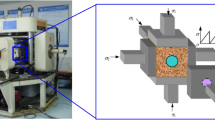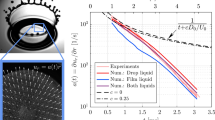Abstract
Certain aspects of wave propagation and the dynamic reaction of a granular material when subjected to a long-duration impulse load are studied. In the majority of studies published on this subject the unsteady pressure behavior at the end-wall covered by a layer of granular material was observed and documented. However, up to now little attention was given to explaining the physical mechanism of this process.
Experimental results, obtained in the course of this study, regarding the pressure fields inside granular layers of different materials, clearly show that the compaction effect strongly depends on the characteristics of the medium. This phenomenon manifests itself by changing the gas-particle interaction in the course of the gas filtration, and by variation in the contribution of the different forces and effective stress, σ, to the energy exchange between the gas, the particles and the shock-tube wall.
The material permeability, f, the relative density, υ, and the particle response time, τp, are the most important parameters affecting the stress formation at the end-wall covered by the granular layer. In addition to the effect of the material parameters, the effective stress, σ, was found to strongly depend on the granular layer height, h. Based on detailed pressure measurements a qualitative analysis regarding the role of the particle rearrangement in the formation of the unsteady peak at the end-wall was performed. The phenomenology of the particle-particle interaction includes rotation and consolidation of the granules and movement or sliding of particle planes within the layer over each other. Most of these processes are frictional in their nature. They are related to the energy losses and affect the profile and magnitude of the compressive stress as measured at the shock-tube end-wall covered by the granular layer.
Similar content being viewed by others
References
Adachi T; Suzuki T; Tanabe K (1984) The pressure waves in a dust layer over which a shock wave is propagating. Theor Appl Mech 32: 211–219
Baer MR (1988) Numerical studies of dynamic compaction of inert and energetic granular materials. Appl Mech 55: 36–43
Bazhenova TV; Gvozdeva LG; Lagutov Yu P; Lakhov VN; Faresov YuM; Fokeev VP (1986) Unsteady interaction of shock and detonation waves in gases. Nauka, Moscow (in Russian). Also translated to English under the same title. Rus. editor Korobeinikov V.P., Eng. editor Urtiev P.A., 1988, Hemisphere, NewYork, pp. 48-61
Ben-Dor G; Britan A; Elperin T; Igra O; Jiang JP (1997) Gas dynamic of granular layers struck by weak shock waves. Exp Fluids (to be published)
Ben-Dor G; Mazor G; Igra O; Sorek S; Onodera H (1994) Shock wave interaction with cellular materials, Part 2: Open cell foams; experimental and numerical results. Shock Waves 3: 167–179
Bracht K; Merzkirch W (1979) Dust entertainment in a shock-induced turbulent air flow. Int J Multiphase Flow 5: 301–312
Britan AB (1993) Shock wave propagation through a foam screen. High Temperature 31: 439–443
Britan AB; Elperin T; Igra 0; Jiang JP (1995) Head-on collision of a planar shock wave with a granular layer. In: Shock compression of condensed matter — 1995, Proc. Conf. Amer. Phys. Soc, Seattle, WA, USA, 2, pp. 971–974
Britan AB; Vasiliev El; Kulikovsky VA (1994) Computer simulation of the shock wave attenuation process inside the foam barrier. Combust Expl Shock Waves 3: 135–142
Britan AB; Zinovik IN (1994) Interaction of pressure waves with a wet foam. J Appl Mech and Tech Phys 35: 712–717
van Dongen MEH; Smeulders DMJ; Kitamura T; Takayama K (1995) On wave phenomena in permeable foam. Acustica 81: 63–70
Dullien FA (1992) Porous media. Academic Press, New York
Fletcher B (1976) The interaction of a shock with a dust deposit. J Phys D Appl Phys 9: 197–202
Gelfand BE; Medvedev SP; Borisov AA; Polenov AN; Frolov SM; Tsyganov SA (1989) Shock loading of stratified dusty system. Combustion 9: 153–165
Goldshtik MA (1984) Transfer processes in granular layer. Academy of Sciences of the USSR, Siberian Branch, Institute of Thermophysics, Novosibirsk
Gvozdeva LG; Faresov YuM; Fokeev VP (1985) Interaction between air shock waves and porous compressible materials. Sov Phys Appl Math Thech Phys 3: 111–115
Gvozdeva LG; Faresov YuM; Sharov YuL (1993) Structure of deformation waves in porous compressible materials under the influence of shock waves: Proc 19th Int Symp Shock Waves, Marseille, France, Vol. 3, pp. 176–180
Igra O; Ben-Dor G (1988) Dusty shock waves. Appl Mech Rev 41: 379–437
Kutushev AG; Rudakov DA (1993) Numerical study of the action of a shock wave on an obstacle screened by a layer of porous powder material. Comb Expl Shock Waves 5: 25–31
Lakhov GM; Polyakova NI (1972) Waves in solid media and loads on structures. Foreign Techn. Div. Air Force System Command, U.S. Air Force, Wright-Patterson AFB, OH, USA
Marble FE (1970) Dynamics of dusty gas. Ann Rev Fluid Mech 2: 120–137
Merzkirch W, Bracht K (1978) The erosion of dust by a shock wave in air: Initial stages with laminar flow. Int J Multiphase Flow 4: 89–95
Molerus O (1993) Principles of flow in disperse systems. Chapman and Hall, London, England
Nesterenko VF (1992) High-rate deformation of heterogeneous materials. Novosibirsk: Nauka, Sib Div
Patz G; Smeets G (1985) Pressure increase in two-phase media behind air shock waves and by shock wave accelerated pistons. Proc 15th Int Symp on Shock Wave and Shock Tube, California, pp. 729–732
Powers JM; Stewart DS; Krier H (1989) Analysis of steady compaction waves in porous materials. Appl Mech 56: 15–24
Rogg B; Hermann D; Adomeit G (1985) Shock-induced flow in regular arrays of cylinders and packed beds. Int J Heat and Mass Transfer 28: 2285–2297
Rudinger G (1973) Wave propagation in suspension of solid particles in gas flow. Appl Mech Rev 26: 273–279
Rudinger G (1980) Fundamental of gas-particle flow. Elsevier, New York
Sakakita H; Hayashi K (1992) Study on interaction between a powder layer and a shock wave. 18th Int. Symp. Shock Waves, Kagoshima, Japan
Skews BW (1991) The reflected pressure field in the interaction of weak shock waves with a compressible foam. Shock Waves 1: 205–211
Skews BW; Atkins MD; Seitz MW (1993) The impact of a shock wave on porous compressible foams. J Fluid Mech 253: 245–265
Stanly-Wood NG (1987) Uniaxial powder compaction. In: Tribology in particulate technology, ed. BJ Briscoe and MJ Adams, pp 249–271. Bristol, England: Adam Higer
Author information
Authors and Affiliations
Rights and permissions
About this article
Cite this article
Britan, A., Ben-Dor, G., Elperin, T. et al. Mechanism of compressive stress formation during weak shock waves impact with granular materials. Experiments in Fluids 22, 507–518 (1997). https://doi.org/10.1007/s003480050078
Received:
Accepted:
Issue Date:
DOI: https://doi.org/10.1007/s003480050078




